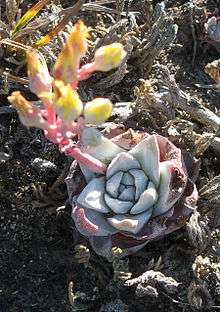Dudleya
| Short-leaved Dudleya | |
|---|---|
| | |
| Short-Leaved Dudleya (Dudleya blochmaniae ssp. brevifolia) at Carmel Mountain, San Diego | |
| Scientific classification | |
| Kingdom: | Plantae |
| (unranked): | Angiosperms |
| (unranked): | Eudicots |
| (unranked): | Core eudicots |
| Order: | Saxifragales |
| Family: | Crassulaceae |
| Genus: | Dudleya Britton & Rose |
| Species | |
|
Numerous, see text. | |
Dudleya is a genus of succulent perennials, consisting of about 45 species in southwest North America.
Many plants in the Dudleya genus were formerly classified as Echeveria.
The fleshy and glabrous leaves occur in basal rosettes, in colors generally ranging from green to gray. The inflorescences are on vertical or inclined stems up to a meter high, but usually much shorter, topped by a cyme with alternate leaf-like bracts. Both the petals and sepals of the small flowers are five in number and fused below. Five pistils, also fused below, have 10 stamens arranged around them.
Dudleya species are widespread in their range, typically found in rock outcroppings, cliff faces, or road cuts, where their leaves help them store water in a setting too dry for most types of plants. Most are small and inconspicuous when not in bloom.
The genus is named after William Russell Dudley, the first head of the botany department at Stanford University.
In horticulture, Dudleya should be planted at an angle. This allows accumulated water to drain from the nestlike center of the plant, thus preventing microbial decay.
Selected species

Dudleya gnoma
- Dudleya abramsii
- Dudleya anthonyi - formerly in Echeveria
- Dudleya attenuata - Orcutt's live-forever, Tapertip live-forever. Formerly in Echeveria, sometimes included in D. edulis
- Dudleya arizonica
- Dudleya blochmaniae
- Dudleya blochmaniae ssp. brevifolia
- Dudleya brittonii
- Dudleya caespitosa - Sea Lettuce. Syn. Echeveria californica, E. cotyledon, E. helleri, E. laxa, Sedum cotyledon.
- Dudleya calcicola - Limestone dudleya
- Dudleya candelabrum
- Dudleya candida - formerly in Echeveria
- Dudleya crassifolia[1]
- Dudleya cultrata - formerly in Echeveria
- Dudleya cymosa - Canyon live-forever. Formerly in Echeveria.
- Dudleya densiflora
- Dudleya edulis - Fingertips. Formerly in Echeveria or Sedum.
- Dudleya farinosa
- Dudleya gnoma - Munchkin dudleya
- Dudleya greenei
- Dudleya guadalupensis
- Dudleya ingens
- Dudleya lanceolata
- Dudleya linearis
- Dudleya multicaulis - Many-stemmed dudleya
- Dudleya nesiotica
- Dudleya pachyphytum - Cedros Island dudleya
- Dudleya palmeri
- Dudleya pulverulenta - Chalk lettuce. Syn. Echeveria argentea, E. pulverulenta, Cotyledon pulverulenta
- Dudleya saxosa - Rock live-forever. Syn. Echeveria collomiae
- Dudleya setchellii - Santa Clara Valley dudleya
- Dudleya stolonifera
- Dudleya traskiae - Santa Barbara Island live-forever
- Dudleya variegata
- Dudleya verityi
- Dudleya virens - Alabaster plant, Island live-forever
- Dudleya viscida - Sticky Dudleya
References
- ↑ Dodero, M. W. and M. G. Simpson. (2012). Dudleya crassifolia (Crassulaceae), a new species from northern Baja California, Mexico. Madroño 59(4) 223-229.
Further reading
- Thompson, P. Dudleya and Hassenthaus Handbook. Bonsall Publications. 1993. ISBN 0-9602066-5-5 ISBN 9780960206650
- Treatment from the Jepson Manual
| Wikimedia Commons has media related to Dudleya. |